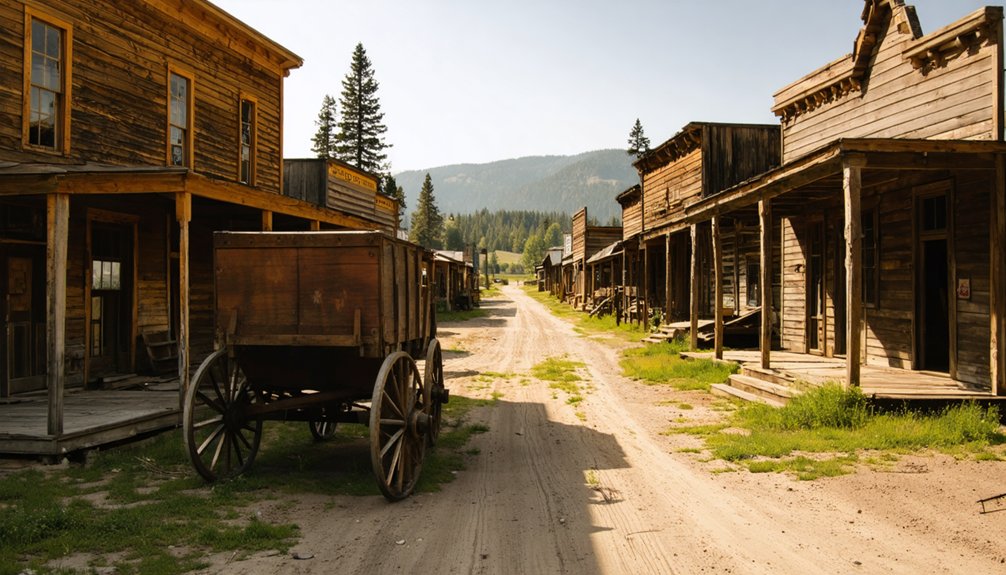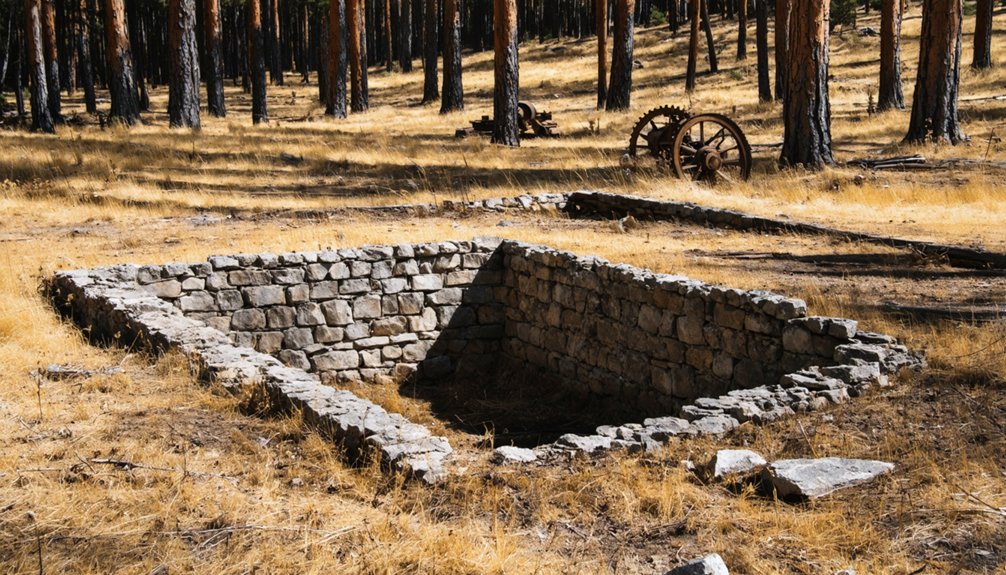Sawmill Flat emerged during the California Gold Rush as a timber-producing settlement that grew to house nearly 1,000 residents by the early 1850s. You’ll find it commemorated as Historical Landmark #424, notable for its two sawmills and the infamous “Battle of Sawmill Flat” between Mexican and American miners. The ghost town sits at 2,136 feet elevation near Columbia in Tuolumne County, accessible via 2WD roads. Its abandoned structures tell a deeper story of boom-and-bust frontier life.
Key Takeaways
- Sawmill Flat, established during the California Gold Rush, is now a ghost town recognized as California Historical Landmark #424.
- Founded in the 1840s for timber production, the town supported mining operations with two sawmills operating by the early 1850s.
- The town once boasted a population of nearly 1,000 residents before declining after the 1857 Columbia fire reduced timber demand.
- Sawmill Flat was the site of the infamous “Battle of Sawmill Flat” between Mexican and American miners over territorial disputes.
- Located at coordinates 38.022874, -120.379774 at 2,136 feet elevation, the ghost town remains accessible via 2WD roads for visitors.
The Birth of a Lumber Town: Origins in the Gold Rush Era
As the California Gold Rush swept across the Sierra Nevada foothills in the late 1840s, the demand for timber to support mining operations gave birth to Sawmill Flat, a settlement that would soon become essential to the region’s economic landscape.
You’ll find that by the early 1850s, two strategic sawmills were established, giving the town its defining name and purpose. These facilities provided the processed lumber vital for mining infrastructure, particularly tunnel supports that prevented deadly collapses. This historical site was officially recognized as California Historical Landmark #424 in 1949.
With abundant forest resources nearby, Sawmill Flat’s lumber production flourished, attracting a population that eventually reached 1,000 residents. Like other lumber towns, Sawmill Flat operated with sled-based table saws for processing wood efficiently.
Surrounded by timber wealth, Sawmill Flat evolved from simple lumber outpost to thriving community of a thousand souls.
The sawmills weren’t merely industrial sites—they represented the economic diversification that sustained many Gold Rush communities beyond pure extraction. Their establishment marked Sawmill Flat as a significant logistical hub for Tuolumne County’s rapid development.
Gold Discoveries and Economic Boom Years
While the sawmills gave the settlement its name, gold discoveries transformed Sawmill Flat into a thriving boomtown during the early 1850s. You’d have found abundant pocket gold deposits that attracted nearly 1,000 residents seeking their fortune during the peak years.
The economic impact extended far beyond the gold mining operations themselves. As you explored the settlement, you’d notice saloons, supply stores, and lodging establishments sprouting up to serve the growing population. The rapid development mirrored other gold rush communities where Chinese miners arrived faster than those traveling from the East Coast.
Miners primarily employed placer mining techniques, using water from nearby streams to separate gold from sediment. The area gained notoriety as a reputed hideout of Joaquin Murieta, one of California’s most infamous bandits of the era.
This prosperity rippled throughout Tuolumne County, stimulating investment in regional infrastructure and complementary industries.
Unfortunately, as easily accessible deposits were exhausted by the late 1850s, the population dwindled and Sawmill Flat gradually transformed from boomtown to ghost town.
Notable Characters and Local Legends
Beneath the surface of Sawmill Flat’s economic narrative lies a colorful tapestry of remarkable individuals and folklore that defined this Gold Rush settlement.
Dona Elisa Martínez stands as a pioneering female mining claim owner who legally secured her rights when few women held such power. Her camp reportedly sheltered the infamous Joaquin Murieta, whose connection to the area deepened its mystique and emphasized the lawlessness of the era. During its prime, the settlement reached a population of approximately 1,000 residents as miners were drawn to the area’s rich pocket gold deposits. The town’s original establishment was driven by the lumber industry’s demand, not the gold rush that later contributed to its growth.
- Experience the legacy of the “Battle of Sawmill Flat,” a mysterious conflict blending documented history with local myth
- Discover how Mexican and Peruvian lumber workers shaped the community while white settlers chased gold dreams
- Explore how these diverse characters transformed a simple industrial site into a complex cultural crossroads
The “Battle of Sawmill Flat” Historical Account
When you visit the site of the Battle of Sawmill Flat today, you’re standing where cultural tensions between Mexican and American miners erupted into open conflict during the Gold Rush era.
These tensions, often amplified by territorial disputes over mining claims and exacerbated by racial prejudices, ultimately led to armed confrontation that would become enshrined in local folklore.
The aftermath of this clash reinforced divisions within mining communities throughout the region, establishing patterns of conflict that would characterize California’s development during this tumultuous period. In its heyday, the area was known for being rich in pocket gold, attracting prospectors from various backgrounds who competed fiercely for valuable claims.
The notorious outlaw Joaquin Murrieta was closely associated with this area, having begun his criminal activities in nearby communities before becoming a legendary figure in California’s history.
Cultural Tensions Erupt
As tensions mounted in the mid-19th century mining camp of Sawmill Flat, the legendary “Battle of Sawmill Flat” emerged as the inevitable culmination of simmering ethnic rivalries and fierce competition for resources.
You’ll find that the clash between Mexican miners led by Doña Elisa Martínez and Anglo prospectors reflected broader cultural clashes throughout Gold Rush California. The battle, now commemorated as California Historical Landmark #424, disrupted mining operations and deepened distrust between ethnic groups.
- Mexican miners’ encampment, rumored to harbor bandits like Joaquin Murieta, stood as a symbol of resistance.
- Competing claims to lucrative mining territories ignited violence when peaceful negotiation failed.
- Stories of this conflict passed through generations, transforming historical conflict into regional legend.
Territorial Dispute Consequences
The “Battle of Sawmill Flat” stands as a watershed moment in California’s Gold Rush history, representing the deadly apex of territorial conflicts that plagued mining communities throughout the 1850s.
You’ll find its legacy preserved today as California Historical Landmark #424, despite the absence of official records confirming exact details.
The aftermath of these miner conflicts transformed the region. Following the bloody dispute, local authorities intensified efforts to establish order amid the prevailing lawlessness.
The battle’s impact extended beyond immediate casualties, influencing the social dynamics of surrounding camps. Joaquin Murieta’s association with the area further cemented Sawmill Flat’s reputation as a dangerous frontier outpost.
When you visit today, the historical markers and preserved stories serve as stark reminders of the violent territorial disputes that defined this tumultuous chapter of western expansion.
Daily Life in a Mother Lode Settlement

Life in a Mother Lode settlement during the Gold Rush era revolved around hardship, opportunity, and improvisation. Your daily routines would center around basic survival in rudimentary dwellings—tents, wooden shanties, or repurposed ship materials.
Life demanded tenacity as gold seekers endured primitive shelters and harsh conditions while chasing fortune in the Mother Lode.
As settlements grew, you’d witness the shift from temporary structures to more permanent buildings like boarding houses and hotels.
- Social gatherings brought relief from mining drudgery, with dancing parties where men might be designated as “ladies” due to gender imbalance.
- Your community hubs would be saloons, boarding houses, and general stores where miners exchanged news and gambled their gold dust.
- Family life adapted to frontier conditions, with women running profitable boarding houses, laundries, and food services while children sometimes joined in mining activities.
The population in these settlements was remarkably diverse, with people from the United States mixing with immigrants from Latin America, Europe, Australia, and 300,000 gold-seekers who arrived by 1855.
For entertainment and cultural experiences, you could attend performances at venues like Maguire’s Opera House where theatrical shows provided a touch of sophistication amid the rugged mining landscape.
From Thriving Community to Abandoned Outpost
Founded during the early 1850s as a critical support hub for neighboring gold mining operations, Sawmill Flat evolved from a modest lumber outpost into a vibrant community of nearly 1,000 residents before its gradual decline into obscurity.
The town’s diverse community dynamics centered around Mexican and Peruvian workers who powered the sawmills while white settlers pursued gold claims nearby. This labor history shaped the settlement’s character, including the notable presence of Doña Elisa Martínez‘s mining camp, rumored to shelter the infamous Joaquin Murieta.
You’ll find the town’s demise traced to the devastating 1857 Columbia fire, which dramatically reduced demand for timber.
As neighboring settlements rebuilt with brick and stone rather than wood, Sawmill Flat’s economic foundation crumbled. Without modernization or economic diversification, the population dwindled, leaving behind only historical markers where a bustling community once stood.
Visiting Sawmill Flat Today: Historical Remains and Landmarks

What remains of Sawmill Flat today offers visitors a stark contrast to its once-thriving past, with the site now primarily marked by California Historical Landmark #424 rather than intact buildings.
Located at 38.022874, -120.379774 (elevation 2,136 feet), the site is easily accessible via 2WD roads. The commemorative plaque, dedicated in 1949, stands as the principal historical signage, detailing the town’s sawmill origins and connections to Dona Elisa Martínez’s mining camp and Joaquin Murieta’s legendary hideout.
- Experience the stark juxtaposition of a ghost town that once housed 1,000 residents during the Gold Rush
- View the landmark plaque sponsored by Odd Fellows and Rebekahs of Tuolumne County
- Explore nearby Columbia for more intact Gold Rush architecture missing from Sawmill Flat
Frequently Asked Questions
Why Did Sawmill Flat Never Incorporate as an Official Town?
You’ll find Sawmill Flat lacked town incorporation due to its transient population, utilitarian origins as a lumber settlement, geographic isolation, and minimal historical significance compared to neighboring established communities.
Were Any Famous Films or Television Shows Filmed at Sawmill Flat?
Surprisingly, despite Tuolumne County’s rich film history, there’s no documented evidence of television productions or famous films being shot at Sawmill Flat—unlike nearby Columbia State Historic Park and Railtown 1897.
What Natural Disasters Affected Sawmill Flat Throughout Its History?
Fires devastated the town most severely, while you’d find earthquakes impacted structures minimally. Flood damage from seasonal creek overflow disrupted operations, and recurring droughts stressed the local economy throughout Sawmill Flat’s existence.
Did Indigenous Peoples Have Settlements Near Sawmill Flat Before 1850?
While definitive records are scarce, you’ll find Indigenous cultures likely maintained seasonal camps, not permanent settlements. Miwok and Ohlone settlement patterns involved resource gathering near waterways—including areas that would later become Sawmill Flat.
Are There Any Annual Events Commemorating Sawmill Flat’s History?
No, there aren’t any documented annual events or historical reenactments commemorating Sawmill Flat’s history. Unlike more prominent ghost towns, it lacks established local traditions celebrating its mining heritage.
References
- https://noehill.com/tuolumne/cal0424.asp
- https://kids.kiddle.co/Sawmill_Flat
- https://idyllwildtowncrier.com/2014/11/10/time-sawmills-common-forest/
- https://en.wikipedia.org/wiki/Sawmill_Flat
- https://thevelvetrocket.com/2010/09/18/california-ghost-towns-grass-flat/
- https://www.ghosttowns.com/states/ca/sawmillflat.html
- https://evendo.com/locations/california/northern-california/landmark/california-historical-landmark-424-sawmill-flat
- https://sierranevadageotourism.org/entries/sawmill-flat-no-424-california-historical-landmark/02744940-0e10-4dd3-a260-d498d957538f
- https://ohp.parks.ca.gov/ListedResources/Detail/424
- https://mtnmouse.com/california/monoa01bodie_state_park_lumber_mill.html



